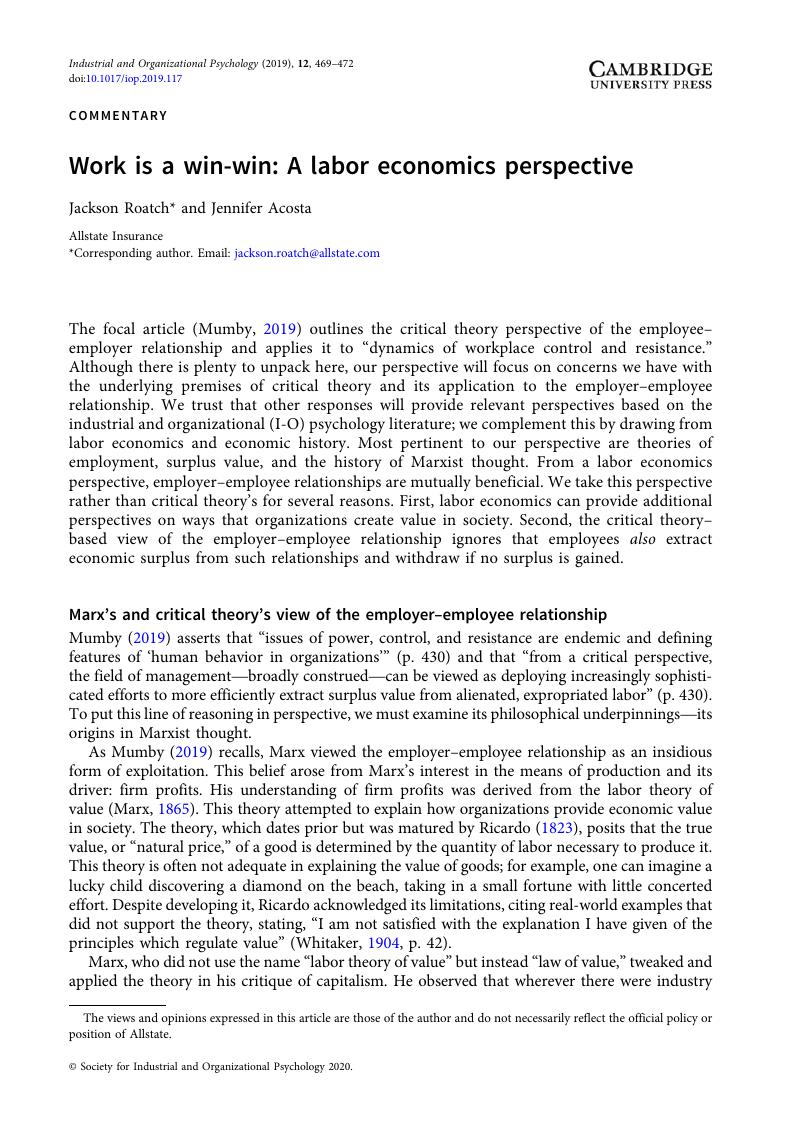No CrossRef data available.
Article contents
Work is a win-win: A labor economics perspective
Published online by Cambridge University Press: 14 January 2020
Abstract
An abstract is not available for this content so a preview has been provided. Please use the Get access link above for information on how to access this content.

- Type
- Commentaries
- Information
- Copyright
- © Society for Industrial and Organizational Psychology 2020
Footnotes
The views and opinions expressed in this article are those of the author and do not necessarily reflect the official policy or position of Allstate.
References
Adams, J. S. (1965). Inequity in social exchange. Advances in Experimental Social Psychology, 2, 267–299.Google Scholar
Berg, T. R. (1991). The importance of equity perception and job satisfaction in predicting employee intent to stay at television stations. Group & Organization Studies, 16(3), 268–284.CrossRefGoogle Scholar
Greenberg, J. (1990). Employee theft as a reaction to underpayment inequity: The hidden cost of pay cuts. Journal of Applied Psychology, 75(5), 561–568.CrossRefGoogle Scholar
Harvey, D. (2018). Marx, capital, and the madness of economic reason. New York, NY: Oxford University Press.Google Scholar
Kable, J. W., & Glimcher, P. W. (2007). The neural correlates of subjective value during intertemporal choice. Nature Neuroscience, 10(12), 1625–1633.CrossRefGoogle ScholarPubMed
Kerr, P., & Harcourt, G. C. (2002). Joan Robinson: Critical assessments of leading economists. London, UK: Routledge.Google Scholar
Marx, K. (1865). Wages, price and profit (4th ed.). Beijing, China: Foreign Languages Press.Google Scholar
Menger, C., Dingwall, J., & Hoselitz, B. F. (1994). Principles of economics. Grove City, PA: Libertarian Press.Google Scholar
Mowday, R. T. (1967). Equity theory: Predictions of behavior in organizations. In Steers, R. M. & Porter, L. W. (Eds.), Motivation & work behavior (pp. 89–110). New York, NY: McGraw-Hill.Google Scholar
Mumby, D. K. (2019). Work: What is it good for? (Absolutely nothing)—a critical theorist’s perspective. Industrial and Organizational Psychology: Perspectives on Science and Practice, 12(4), 429–443.Google Scholar
Ricardo, D. (1823). Absolute value and exchange value. In Sraffa, P. with Dobb, M. H. (Eds.), The works and correspondence of David Ricardo (Vol. 4, pp. 88–92). Liberty Fund Inc.Google Scholar
Tarling, R. (1987). Labour markets. In Durlauf, S. N. & Blume, L. (Eds.), The New Palgrave dictionary of economics (pp. 1–4). Basingstoke, UK: Palgrave Macmillan.Google Scholar
Whitaker, A. (1904). History and criticism of the labor theory of value in English political economy. New York, NY: Columbia University Press.CrossRefGoogle Scholar




